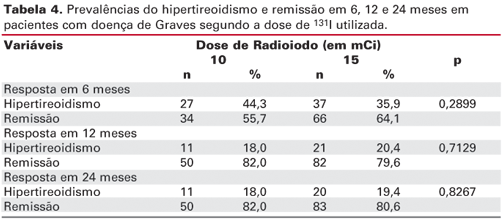The treatment options for the hyperthyroidism of Graves’ disease are antithyroid drugs, surgery and radioiodine, none of which is considered ideal, as they do not act directly on the etiopathogenesis of the disease. Radioiodine has been increasingly used as the treatment of choice because it is a safe and definitive therapy whose administration is very easy. Some authors prefer to administer higher doses in order to deliberately induce hypothyroidism, while others recommend lower doses that result in a lower incidence of hypothyroidism and a greater incidence of euthyroidism. There is no consensus for the optimal regimen of fixed doses to be used and this is the main focus of the present study, where doses of 10 and 15 mCi of 131I were compared. Among the 164 patients analyzed, 61 (37.2%) were submitted to 10 mCi and 103 (62.8%) to 15 mCi. In the longitudinal analysis it was observed that remission of the hyperthyroidism was statistically different in the sixth month (p < 0.001), being higher in the group that used the dose of 15 mCi, but similar in both groups at 12 and 24 months. It may be concluded that the administration of fixed doses of 10 and 15 mCi of 131I brought about a similar remission of the hyperthyroidism after 12 months of treatment. Moreover, the remission rate of the hyperthyroidism had no association with age, sex or previous therapy with antithyroid drugs.
Graves’ disease; Hyperthyroidism; Radioiodine; Antithyroid drugs





